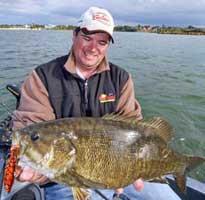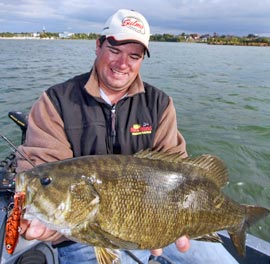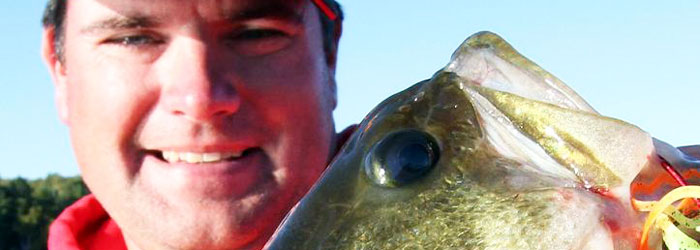Open Water Bass

So what causes a bass to leave the sanctuary and safety that cover or structure provides? Typically the answer is always a meal.
The hardest adjustment for many bass anglers to make is to pursue open water fish that are cruising away from structure. Most of the season we are aiming at targets that make sense: cover that holds bass. To wake up one morning and turn that switch off can be really difficult. When fish leave the sanctuary of cover and wander the abyss, the reasons can vary from one fishery to the next.
The timing can also vary drastically. On some reservoirs, bass might follow shad out over open water late in the summer and the activity might peak early in the morning or right at sunset. On some lakes bug hatches might be triggering activity off the shoreline high in the water column and the action might peak during the mid day when the sun is high.
There are sometimes obvious clues for this activity like busting baitfish. When we can physically see baitfish or even bass, the search gets narrowed and confidence improves. What can make bass that are not relating to the typical structure even more frustrating is that these fish are usually on the move, drifting and cruising through areas in packs looking for baitfish.
As anglers, the best thing we can have happen to us when fishing is to physically see some surface activity.
 Surface Activity
Surface Activity
What happens however when we don’t get lucky and physically see a frantic school of shad busting the surface with piranha minded bass pushing below? Often as well, bass that we can see are much more difficult to catch than the fish we cannot see. If you are only fishing open water bass when the baitfish jump out of the water or you can see fish, you are missing out on opportunities.
High in Water Column
One of the first things to determine is just how high in the water column most of the fish are relating. Realize as well that fish move up and down over the course of a day. In my mind, if the fish are deeper than 10 feet, I will see them with my electronics. Shallower fish right under the surface are often pretty tough to see with electronics so if deeper clutter and activity on the depth finder starts to disappear, look high. Breaking down this open water however can be an intimidating proposition none the less.
Why do Bass Leave Cover?
Even fish that are cruising through open water chasing baitfish are typically somehow relating to some type of big structure like a creek channel, deep break, docks, bridge piling or some other kind of structure. While the fish might be out over deep water or cruising through shallow water away from the traditional cover, these fish are still often merely straying from sanctuaries when conditions are right.
So what causes a bass to leave the sanctuary and safety that cover or structure provides? Typically the answer is always a meal. With that being said, you can often approach these fish with a very aggressive mindset and presentation.
Fishing Fast
Open water bass that are not relating to structure have plenty of room to run down a lure so the windows of opportunity are often broad. Long casts often shine where the last crank can be as productive as the first crank. Typically, I have been much more effective targeting these situations with speed and fish fast. Fishing fast means I get to make more casts but over open water. I believe speed is a powerful trigger that causes fish to react.
One of my favorite techniques for covering water is to bomb cast heavy spinner baits with long casts and reel the baits back fast. The beauty of spinnerbaits is that you can count them down to different parts of the water column until you find the zone.
Willow Leaf Spinnerbaits
Large heavy 1 ounce or heavier willow leaf spinnerbaits can be burned through a variety of depths and can be whipped a long way from the boat. When you do contact fish, time is everything because these fish typically drift away or the spot gets screwed up by fish following the fish you are reeling in.
When the fish are snapping, strike fast but don’t get hung up on an icon or waypoint because the next flurry will usually be somewhere else nearby. Crankbaits are another solid option for covering water but the weight of crankbaits makes it more difficult to cast cross wind or up wind compared to a large spinnerbait. For fish high in the water, rattle baits like the Salmo Zipper are tough to beat. The Zipper has a really loud rattle that seems to be the reason fish like that particular lure so much.
When Bass are in Cover
When bass seem to be vacating the traditional structure and cover, spend some time over adjacent open water and look for baitfish activity. Come mid to late summer, these nomadic fish can be a very consistent pattern that some anglers overlook.
While the open zone of water away from structure can indeed be intimidating, fishing through these locations quickly can even the odds and make you very efficient at combing this water.
About Jason Mitchell
Jason Mitchell hosts the popular outdoor program Jason Mitchell Outdoors which airs across the Midwest on Fox Sports North and Fox Sports Midwest. Before television, Mitchell earned a reputation as a top hunting and fishing guide on Devils Lake, North Dakota where he spent over two hundred and fifty days each season on the water and ice for over a decade. Mitchell shares his insights and tactics learned from an extensive amount of time on the water in each article.
Jason shares more of his experience in these articles



